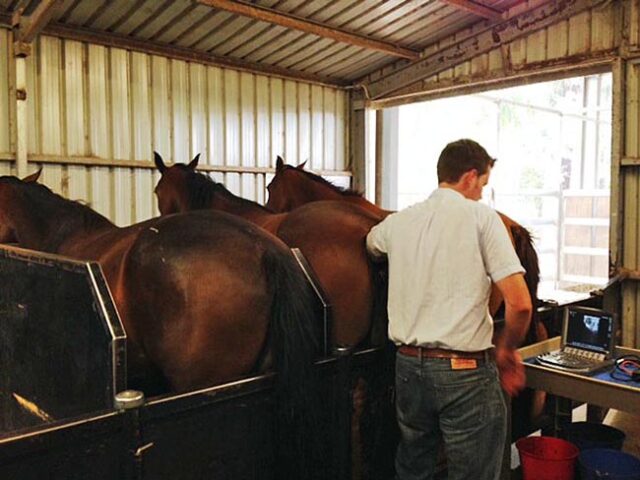By Dr. Elena Martinez de Andino
Photography: Select Breeders Services
To evaluate a mare’s potential for reproductive success or failure, veterinarians often perform a ‘breeding soundness examination’ (BSE). As the breeding season approaches, many owners may opt for a pre-breeding BSE to identify and address any potential reproductive issues prior to breeding.
This examination is invaluable for estimating the likelihood of a mare successfully conceiving, carrying a pregnancy to term, and delivering a healthy foal. Pre-breeding examinations are usually performed early in the breeding season when the mare has just begun to cycle or, at the very least, is not in anestrus. Furthermore, the BSE provides veterinarians and owners with important information to determine whether a particular mare should carry a foal herself or whether she might better serve as an embryo or oocyte donor, as well as what breeding strategies are most appropriate for the individual mare.
In addition to its utility as a pre-breeding assessment, a thorough BSE is also highly recommended for anyone looking to purchase a prospective broodmare. Pre-purchase BSEs provide critical insights concerning the potential value of a mare as a breeding prospect. Finally, BSEs are also indicated for evaluation of ‘problem’ mares with a history of subfertility or unexplained infertility. In all cases, a timely BSE provides essential information for both the owner and veterinarian to optimize breeding management strategy.
This article will review the components of a standard breeding soundness examination and touch upon ancillary diagnostics and treatments that may be pursued to work up sub-fertile mares. The standard BSE includes:
• collection of a thorough and detailed patient history
• general physical examination
• examination of the external reproductive genitalia
• palpation and ultrasonography per rectum
• uterine culture, cytology, biopsy, and/or low volume lavage
• manual/visual vaginal examination.
Patient history
The first step of every BSE is the collection of reproductive history which is crucial to evaluating the current status of the mare (e.g., maiden, foaling, or barren). General patient information includes a mare’s age, breed, general health, previous athletic use, vaccination and deworming history, previous injuries or illnesses, and identification of any medications currently and/or previously administered. More specific information regarding a mare’s reproductive history may include details of the mare’s estrous cycle (such as length and behavior, teasing method, etc.), current stage of the cycle if known, prior or planned breeding dates, previous pregnancy information, and overall uterine health.
More advanced inquiries will generally be pursued for mares with a more extensive subfertility history... To read the complete article you need to be a subscriber
CLICK HERE TO SUBSCRIBE TO BREEDING NEWS
SUBSCRIBERS CAN READ THE COMPLETE ARTICLE BY LOGGING IN AND RETURNING TO THIS PAGE




